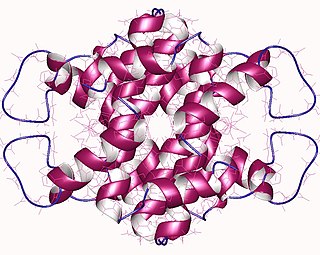
Thiamine, also known as thiamin and vitamin B1, is a vitamin, an essential micronutrient for humans and animals. It is found in food and commercially synthesized to be a dietary supplement or medication. Phosphorylated forms of thiamine are required for some metabolic reactions, including the breakdown of glucose and amino acids.

In chemistry, pyrophosphates are phosphorus oxyanions that contain two phosphorus atoms in a P–O–P linkage. A number of pyrophosphate salts exist, such as disodium pyrophosphate (Na2H2P2O7) and tetrasodium pyrophosphate (Na4P2O7), among others. Often pyrophosphates are called diphosphates. The parent pyrophosphates are derived from partial or complete neutralization of pyrophosphoric acid. The pyrophosphate bond is also sometimes referred to as a phosphoanhydride bond, a naming convention which emphasizes the loss of water that occurs when two phosphates form a new P–O–P bond, and which mirrors the nomenclature for anhydrides of carboxylic acids. Pyrophosphates are found in ATP and other nucleotide triphosphates, which are important in biochemistry. The term pyrophosphate is also the name of esters formed by the condensation of a phosphorylated biological compound with inorganic phosphate, as for dimethylallyl pyrophosphate. This bond is also referred to as a high-energy phosphate bond.

Thiamine triphosphate (ThTP) is a biomolecule found in most organisms including bacteria, fungi, plants and animals. Chemically, it is the triphosphate derivative of the vitamin thiamine.
Adenosine thiamine triphosphate (AThTP), or thiaminylated adenosine triphosphate, is a natural thiamine adenine nucleotide. It was discovered in Escherichia coli where it may account for up to 15 - 20% of total thiamine under carbon starvation. AThTP also exists in eukaryotic organisms such as yeast, roots of higher plants and animal tissues, albeit at a much lower concentration. It was found to exist in small amounts in the muscle, heart, brain, kidneys and liver of mice.
Pyrophosphatases, also known as diphosphatases, are acid anhydride hydrolases that act upon diphosphate bonds.
In enzymology, an ATP diphosphatase (EC 3.6.1.8) is an enzyme that catalyzes the chemical reaction
In enzymology, a bis(5'-adenosyl)-triphosphatase (EC 3.6.1.29) is an enzyme that catalyzes the chemical reaction
In enzymology, a dCTP diphosphatase (EC 3.6.1.12) is an enzyme that catalyzes the chemical reaction

In Enzymology, a dUTP diphosphatase (EC 3.6.1.23) is an enzyme that catalyzes the chemical reaction
In enzymology, a guanosine-5'-triphosphate,3'-diphosphate diphosphatase (EC 3.6.1.40) is an enzyme that catalyzes the chemical reaction

In enzymology, a nucleoside-diphosphatase (EC 3.6.1.6) is an enzyme that catalyzes the chemical reaction
In enzymology, a nucleoside-triphosphatase(NTPase) (EC 3.6.1.15) is an enzyme that catalyzes the chemical reaction
In enzymology, a nucleoside-triphosphate diphosphatase (EC 3.6.1.19) is an enzyme that catalyzes the chemical reaction

In enzymology, a phosphoribosyl-ATP diphosphatase (EC 3.6.1.31) is an enzyme that catalyzes the chemical reaction
In enzymology, a thymidine-triphosphatase (EC 3.6.1.39) is an enzyme that catalyzes the chemical reaction
In enzymology, a triphosphatase (EC 3.6.1.25) is an enzyme that catalyzes the chemical reaction
The enzyme polynucleotide 5′-phosphatase (RNA 5′-triphosphatase, RTPase, EC 3.1.3.33) is an enzyme that catalyzes the reaction
In enzymology, a polyphosphate kinase, or polyphosphate polymerase, is an enzyme that catalyzes the formation of polyphosphate from ATP, with chain lengths of up to a thousand or more orthophosphate moieties.
In enzymology, a thiamine-diphosphate kinase is an enzyme involved in thiamine metabolism. It catalyzes the chemical reaction
In enzymology, a thiamine diphosphokinase is an enzyme that catalyzes the chemical reaction






